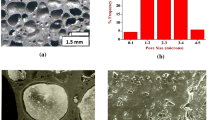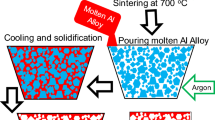Abstract
The expansion of molten aluminum foam was studied to determine flow mechanisms in the cellular melt. The structure of the foaming melt evolved through a series of deformation stages before the foam stabilized and solidified. Changes in cell geometry during foam expansion were observed at different positions within the mold cavity and analyzed to determine flow mechanisms. The deformation patterns and cell shapes during foam expansion were observed macroscopically and microscopically from metallographic sections. Simple mechanical models described the salient features and mechanisms of the expansion process.



















Similar content being viewed by others
References
L.J. Gibson and M.F. Ashby: Cellular Solids, Cambridge Press, Cambridge, United Kingdom, 1997, pp. 1–2
J. Banhart, J. Baumeister: J. Mater. Sci., 1998, vol. 33, p. 1431
D.M. Elzey, H.N. Wadley: Acta Mater., 2000, vol. 49, pp. 849–59
C. Park and S.R. Nutt: Mater. Sci. Eng. A, 2000, vol. 288, pp. 111–118; 2001, vol. 297, pp. 62–68
B. Sosnick: U.S. Patent 2,553,016, 1947
J.C. Elliott: U.S. Patent 2,751,289, 1956; U.S. Patent 2,983,597, 1961
P.W. Hardy and G.W. Peisker: U.S. Patent 3,300,296, 1967
C.B. Berry: U.S. Patent 3,669,654, 1972
H. Unno, S. Akiyama: Light Metal 1987, vol. 37, pp. 42–47 (in Japanese)
A.M. Krayni: Ann. Rev. Fluid Mech., 1988, vol. 20, pp. 325–57
D. Weaire, S. Hutzler: The Physics of Foams, Oxford University, United Kingdom, 1999, pp. 75–173
J. Banhart, H. Stanzick, L. Helfen, T. Baumbach: Appl. Phys. Lett., 2001, vol. 78 (8), pp. 1152–54
I. Duarte, J. Banhart: Acta Mater., 2000, vol. 48, pp. 2349–62
J. Banhart, D. Bellmann, H. Clemens: Acta Mater., 2001, vol. 49, pp. 3409–20
Z. Song, L. Ma, Z. Wu, D. He: J. Mater. Sci., 2000, vol. 35 (1), p. 15
Z. Song, J. Zhu, L. Ma, D. He: Mater. Sci. Eng. A, 2001, vol. 298, pp. 137–43
Z. Song: Ph.D. Thesis, Southeast University, Nanjing, China, 1998
R.K. Prud’homme, R.B. Bird: J. Non-Newtonian Fluid Mech., 1978, vol. 3, pp. 261–79
H.M. Princen: J. Coll. Interface Sci., 1985, vol. 105, pp. 150–71
A.M. Kraynik, M.G. Hansen: J. Rheology, 1987, vol. 31 (0), pp. 175–205
D. Weaire, T.L. Fu: J. Rheology, 1988, vol. 32 (3), pp. 271–83
S.A. Khan, R.C. Armstrong: J. Rheology, 1989, vol. 33 (6), pp. 881–911
M. Mooney: J. Rheology, 1931, vol. 2, pp. 210–22
M. Blackman: Trans. Faraday Soc., 1948, vol. 44, pp. 205–06
H.M. Princen: J. Coll. Interface Sci., 1985, vol. 105, pp. 150–71
J.A.F. Plateau: Statique Expérimentale et Théorique des Liquides Soumis aux Seules Forces Moléculaires, Gauthier-Villars, Paris, 1873, pp. 108–91
Lord Kelvin (D. Thompson): Philos. Mag., 1887, vol. 24, pp. 503–04.
D. Thompson: On Growth and Form, Cambridge University, Cambridge, United Kingdom, 1961, chapter 4
H.G. Wenzel, T.E. Stelson, R.J. Brungraber: J. Mater., 1970, vol. 5, pp. 396–412
R.A. Saravanan, J.M. Molina, J. Narciso, C. Garca-Cordovilla, and E. Louis: Scripta Mater., 2001, vol. 44, pp. 965–70
R.P. Benedict: Fundamentals of Pipe Flow, John Wiley & Sons, New York, 1980, pp. 178–90
E. Hatschek: Trans. Faraday Soc., 1913, vol. 9, pp. 80–92
Acknowledgment
The authors are grateful to the Merwyn C. Gill Foundation and National Major Project of Fundamental Research 2006CB601201, and ZJNSF Y406459 for support of this work.
Author information
Authors and Affiliations
Corresponding author
Additional information
Manuscript submitted June 19, 2007.
Appendices
Appendix A
1.1 Expansion ratio and rate
The expansion ratio (e(t)) and expansion rate (\( \ifmmode\expandafter\dot\else\expandafter\.\fi{e}(t) \)) of the foaming melt are functions of holding time in the process. These quantities can be expressed as
where V 0 and V(t) are the original volume and the dynamic volume of the foaming melt, respectively. Both parameters were measured.
For convenience of describing the kinetics, the logarithmic expansion ratio (E(t)) and logarithmic expansion rate (\( \ifmmode\expandafter\dot\else\expandafter\.\fi{E}(t) \)) can be defined as
The relations between E(t) and e(t), and between \( \ifmmode\expandafter\dot\else\expandafter\.\fi{E}(t) \) and \( \ifmmode\expandafter\dot\else\expandafter\.\fi{e}(t) \) are
Isothermal melt conditions permit one to observe foam expansion after the blowing agent is added. A device was employed for detecting the height of the expanding foam,[16] and in a cylindrical crucible, the height of the foam (H(t)) is a function of hold time. The relations between H(t), expansion ratio and expansion rate are
respectively, where H 0 and H(t) are the original height and the dynamic height of the foaming melt, respectively.
Appendix B
1.1 Porosity
Perhaps the most critical characteristic of foam is the porosity (p)
The relation between the instantaneous specific density of the expanding foam ρ f and the expansion ratio is
where ρ 0 is the density of the melt metal.
Rights and permissions
About this article
Cite this article
Song, Z., Nutt, S. Expansion Mechanisms in Foaming Aluminum Melts. Metall Mater Trans A 39, 2215–2227 (2008). https://doi.org/10.1007/s11661-008-9573-7
Published:
Issue Date:
DOI: https://doi.org/10.1007/s11661-008-9573-7




